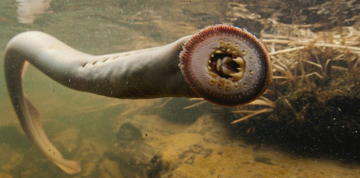Lamprey_edit.png

Female lampreys use odor receptors in their nose to detect the pheromone spermine contained in the semen of male lampreys. Credit: Dave Herasimtschuk, US Fish & Wildlife Service.
A key aspect of sexual attraction for many animals is the involvement of pheromones—chemicals secreted by an animal that other members of that species respond to. It’s no different for lampreys, an eel-shaped parasitic fish with a formidable suction-cup mouth. For these creatures, what attracts female lampreys to potential mates is the enticing smell of sperm. A compound called spermine is present in the semen of a wide range of animals, including humans, but scientists have only recently discovered that spermine is a strong aphrodisiac for female lampreys that are ready to mate.
Scientists have already been replicating pheromone odors that attract lampreys and using it to improve their population-control methods, and now spermine can become another tool in their toolbox. The research required testing nearly 12,000 pairs of chemicals against lamprey odor receptors to discover the pair that matched. Researchers learned that female lampreys use spermine to pick the best mates living near the gravel beds in streams, where they can spawn several times an hour.
The discovery has led to new strategies for controlling sea lampreys in the Great Lakes, where they’ve become a particularly destructive invasive species over the past century and a half. Though native to the Atlantic Ocean, sea lampreys made their way to the Great Lakes in the 1830s and have been tearing away the flesh of lake fish and sucking out their insides ever since. Each lamprey consumes an estimated 40 pounds of fish every year. U.S. and Canadian regulatory agencies have worked together to reduce the impact of lampreys in the region using barriers, traps, and lampricides—chemicals that are deadly to lamprey larvae but harmless to other animals—in streams that flow into the lakes.


